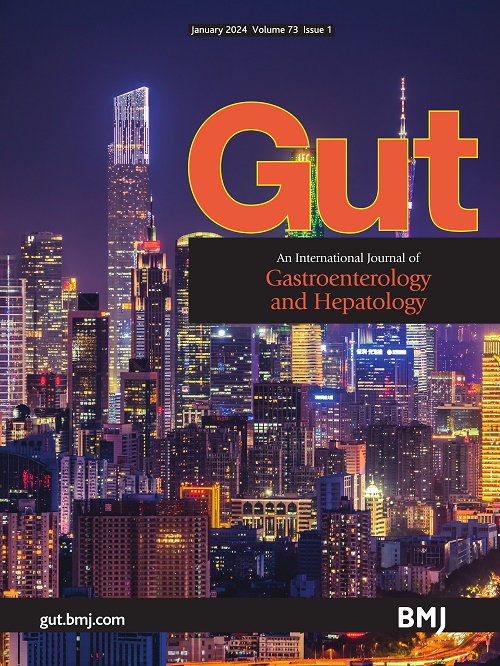大规模多组学分析确定了非编码体细胞驱动突变,并指定ZFP36L2为胰腺导管腺癌的驱动基因
IF 25.8
1区 医学
Q1 GASTROENTEROLOGY & HEPATOLOGY
引用次数: 0
摘要
非编码基因组中体细胞癌驱动突变的鉴定和表征仍然具有挑战性。目的探讨胰腺导管腺癌(PDAC)的非编码驱动突变特征。利用来自pdac全基因组序列数据的突变调用和正常来源和肿瘤来源胰腺样本中可访问的基因调控区域的基因组尺度图,我们分析了与正常来源和肿瘤来源胰腺相关的基因调控区域的非编码突变富集情况。利用染色质相互作用分析、大规模平行报告基因分析(MPRA)和选择性非编码体细胞突变(ncsm)进行潜在驱动突变的功能随访。我们首先在胰腺细胞系和纯化的胰腺腺泡细胞和胰腺导管细胞中建立了可接近的染色质区域(ACRs)和组蛋白修饰标记(hmm)的基因组尺度图谱。与来自506个pdac的全基因组突变呼叫整合,发现314个ACRs/ hmm显著富集3614个ncsm。染色质相互作用分析鉴定出416个潜在靶基因,MPRA发现178个ncsm影响报告基因活性(占被测基因的19.45%)。靶向荧光素酶验证证实了ZFP36L2和CDKN2A附近ncsm基因调控活性的负面影响。对于前者,CRISPR干扰鉴定ZFP36L2为靶基因(表达降低16.0-24.0%,p= 0.023-0.0047), ZFP36L2过表达后的生长抑制(降低4.1- 14.1倍,p= 6.0×10-4−3.2×10-3)暗示可能具有肿瘤抑制功能。结论我们的综合方法提供了潜在的非编码驱动突变目录,并提名ZFP36L2为可能具有肿瘤抑制功能的新型PDAC驱动基因。数据可以在一个公共的、开放访问的存储库中获得。数据可能会从第三方获得,并且不会公开提供。数据可以在公共的开放存取存储库中获得,也可以从第三方获得,但不是公开可用的。作为本工作的一部分创建的或在本研究中使用的并可通过第三方获得的所有数据集都列在数据可用性部分的在线方法部分中。本文章由计算机程序翻译,如有差异,请以英文原文为准。
Large-scale multiomic analysis identifies non-coding somatic driver mutations and nominates ZFP36L2 as a driver gene for pancreatic ductal adenocarcinoma
Background The identification and characterisation of somatic cancer driver mutations in the non-coding genome remains challenging. Objective To broadly characterise non-coding driver mutations for pancreatic ductal adenocarcinoma (PDAC). Design Using mutation calls from whole-genome sequence data in PDACs and genome-scale maps of accessible gene regulatory regions in normal-derived and tumour-derived pancreatic samples, we analysed enrichment of non-coding mutations in gene regulatory regions relevant to normal-derived and tumour-derived pancreatic contexts. Functional follow-up of potential driver mutations was performed using chromatin interaction analyses, massively parallel reporter assays (MPRA) and targeted analysis of selected non-coding somatic mutations (NCSMs). Results We first created genome-scale maps of accessible chromatin regions (ACRs) and histone modification marks (HMMs) in pancreatic cell lines and purified pancreatic acinar and duct cells. Integration with whole-genome mutation calls from 506 PDACs revealed 314 ACRs/HMMs significantly enriched with 3614 NCSMs. Chromatin interaction analysis identified 416 potential target genes and MPRA revealed 178 NCSMs impacting reporter activity (19.45% of those tested). Targeted luciferase validation confirmed negative effects on gene regulatory activity for NCSMs near ZFP36L2 and CDKN2A . For the former, CRISPR interference identified ZFP36L2 as a target gene (16.0–24.0% reduced expression, p=0.023–0.0047), and growth inhibition after overexpression of ZFP36L2 (4.1–14.1-fold reduction, p=6.0×10–4 − 3.2×10–3) implicates a possible tumour suppressor function. Conclusion Our integrative approach provides a catalogue of potential non-coding driver mutations and nominates ZFP36L2 as a novel PDAC driver gene with a likely tumour suppressor function. Data are available in a public, open access repository. Data may be obtained from a third party and are not publicly available. Data are available in a public, open access repository or may be obtained from a third party and are not publicly available. All data sets created as part of this work or used in this study and available through third parties, are listed in the Online Methods section under the Data availability section.
求助全文
通过发布文献求助,成功后即可免费获取论文全文。
去求助
来源期刊

Gut
医学-胃肠肝病学
CiteScore
45.70
自引率
2.40%
发文量
284
审稿时长
1.5 months
期刊介绍:
Gut is a renowned international journal specializing in gastroenterology and hepatology, known for its high-quality clinical research covering the alimentary tract, liver, biliary tree, and pancreas. It offers authoritative and current coverage across all aspects of gastroenterology and hepatology, featuring articles on emerging disease mechanisms and innovative diagnostic and therapeutic approaches authored by leading experts.
As the flagship journal of BMJ's gastroenterology portfolio, Gut is accompanied by two companion journals: Frontline Gastroenterology, focusing on education and practice-oriented papers, and BMJ Open Gastroenterology for open access original research.
 求助内容:
求助内容: 应助结果提醒方式:
应助结果提醒方式:


